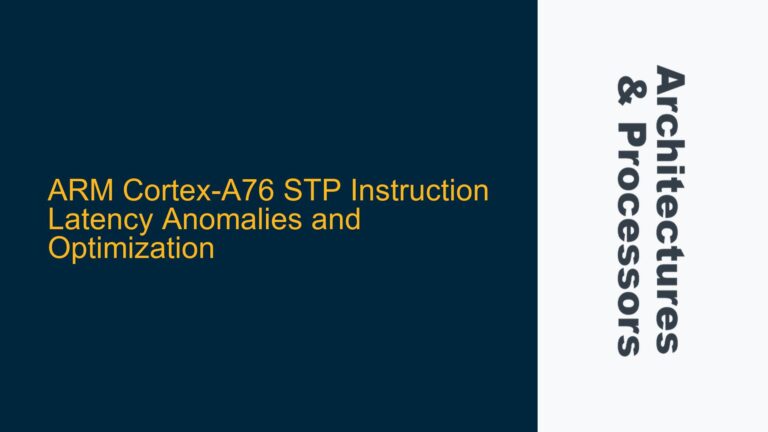ARM Cortex-M33 LED Toggle Subroutine Cycle Count Analysis
The ARM Cortex-M33 is a highly efficient microcontroller core designed for embedded applications, offering a balance of performance, power efficiency, and security features. One common task in embedded systems is toggling an LED, which, while seemingly simple, can be a useful benchmark for understanding the cycle count and performance characteristics of the processor. The subroutine in question involves toggling an LED by manipulating a memory-mapped I/O register in an infinite loop. The goal is to determine the exact cycle count for one iteration of this loop, which is critical for timing-sensitive applications and performance optimization.
The subroutine provided is written in ARM assembly and consists of the following instructions:
ToggleLED_Subroutine PROC
LDR R0, =0x40302000 ; FPGAIO Base Address (0x40302000) + LED_OFFSET (0)
MOV R2, #3
Loop
LDR R1, [R0]
EOR R1, R1, R2
STR R1, [R0]
B Loop
ENDP
This code loads the base address of the FPGA I/O register into R0, initializes R2 with the value 3, and then enters an infinite loop where it reads the current value of the I/O register, XORs it with R2, writes the result back to the register, and branches back to the start of the loop. The cycle count for this subroutine depends on several factors, including the Cortex-M33 pipeline, memory access timing, and the specific implementation of the instructions.
Cortex-M33 Pipeline and Instruction Timing Variability
The Cortex-M33 is based on the ARMv8-M architecture and features a 3-stage pipeline (Fetch, Decode, Execute) with optional enhancements such as branch prediction and single-cycle I/O access. However, the exact cycle count for each instruction is not explicitly defined by the ARM architecture but is instead implementation-dependent. This variability arises from factors such as memory wait states, pipeline stalls, and the presence of caches or prefetch units.
For example, the LDR instruction, which loads a value from memory, typically takes 2 cycles if the data is available in the cache or a single-cycle buffer. However, if the data is not immediately available, additional wait states may be introduced, increasing the cycle count. Similarly, the STR instruction, which stores a value to memory, may also experience delays depending on the memory subsystem’s responsiveness.
The EOR (Exclusive OR) instruction is an arithmetic operation that usually completes in a single cycle, assuming no pipeline stalls. The B (Branch) instruction, which performs an unconditional branch, typically takes 2 cycles due to the pipeline flush and refill that occurs when the branch is taken.
In the context of the provided subroutine, the cycle count for one iteration of the loop can be estimated by summing the cycle counts of the individual instructions. However, this estimation must account for potential pipeline stalls, memory access delays, and other implementation-specific factors.
Debug Features and Cycle Count Measurement Techniques
To accurately measure the cycle count of the LED toggle subroutine, developers can leverage the debug features provided by the ARM Cortex-M33 architecture. One of the most useful tools for this purpose is the Data Watchpoint and Trace Unit (DWT), which includes a Cycle Count Register (DWT_CYCCNT). This register increments with each processor cycle and can be used to measure the elapsed cycles between two points in the code.
To use the DWT_CYCCNT register, developers must first enable the DWT unit and configure the cycle counter. This involves setting the appropriate bits in the Debug Exception and Monitor Control Register (DEMCR) and the DWT Control Register (DWT_CTRL). Once enabled, the cycle counter can be read at the start and end of the subroutine to determine the total cycle count.
For example, the following steps outline how to measure the cycle count using the DWT_CYCCNT register:
- Enable the DWT unit by setting the TRCENA bit in the DEMCR register.
- Enable the cycle counter by setting the CYCCNTENA bit in the DWT_CTRL register.
- Read the DWT_CYCCNT register at the start of the subroutine and store the value in a variable.
- Execute the subroutine.
- Read the DWT_CYCCNT register again at the end of the subroutine and calculate the difference between the two readings.
This method provides a highly accurate measurement of the cycle count, accounting for all pipeline effects and memory access delays. However, it requires that the target device includes the necessary debug features and that the development environment supports access to the DWT registers.
In cases where the DWT unit is not available, developers can use the SysTick timer as an alternative method for cycle count measurement. The SysTick timer is a 24-bit down-counter that can be configured to run at the processor’s clock frequency. By reading the SysTick timer before and after the subroutine, developers can estimate the cycle count based on the elapsed time.
Implementing Cycle Count Measurement and Optimization Strategies
To implement cycle count measurement for the LED toggle subroutine, developers should follow a systematic approach that combines theoretical analysis with practical measurement techniques. The following steps outline this process:
-
Theoretical Analysis: Begin by analyzing the subroutine’s assembly code and estimating the cycle count for each instruction based on the Cortex-M33 pipeline and memory subsystem characteristics. This provides a baseline understanding of the expected performance.
-
Enable Debug Features: If the target device supports the DWT unit, enable the cycle counter by configuring the DEMCR and DWT_CTRL registers. This allows for precise cycle count measurement during execution.
-
Instrument the Code: Insert code to read the DWT_CYCCNT register at the start and end of the subroutine. Store the cycle count values in variables for later analysis.
-
Execute and Measure: Run the subroutine in a controlled environment, such as a debugger or emulator, and record the cycle count measurements. Repeat the process multiple times to ensure consistency and account for any variability.
-
Analyze Results: Compare the measured cycle counts with the theoretical estimates. Identify any discrepancies and investigate potential causes, such as pipeline stalls or memory access delays.
-
Optimize the Code: Based on the analysis, implement optimizations to reduce the cycle count. This may involve rewriting the assembly code to minimize pipeline stalls, optimizing memory access patterns, or leveraging hardware features such as single-cycle I/O.
-
Validate Optimizations: After making changes, repeat the cycle count measurement process to validate the improvements. Ensure that the optimizations do not introduce unintended side effects or reduce the reliability of the subroutine.
By following these steps, developers can gain a deep understanding of the Cortex-M33’s performance characteristics and optimize their code for maximum efficiency. This approach is particularly valuable in timing-sensitive applications, where precise control over execution time is critical.
In conclusion, measuring the cycle count for an LED toggle subroutine on the ARM Cortex-M33 requires a combination of theoretical analysis and practical measurement techniques. By leveraging the DWT unit or SysTick timer, developers can obtain accurate cycle count measurements and use this information to optimize their code. This process not only improves the performance of the specific subroutine but also enhances the overall efficiency and reliability of the embedded system.






